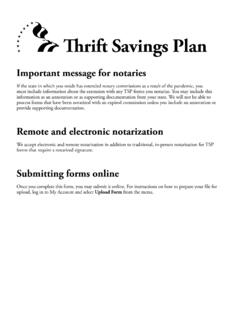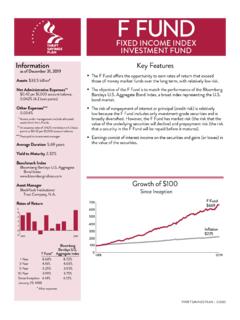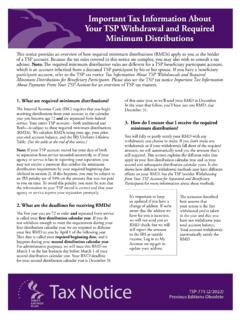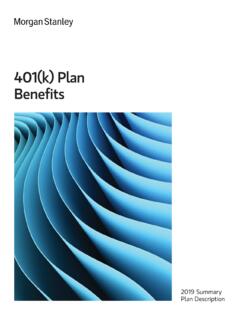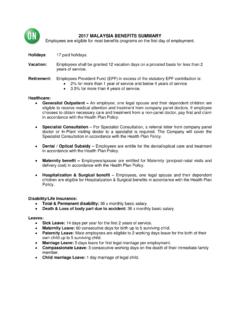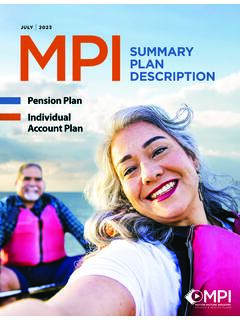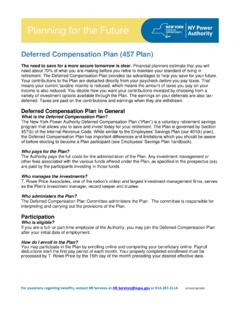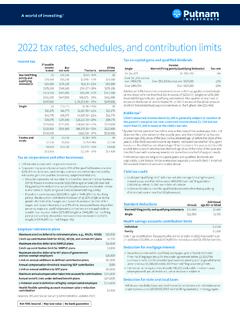Transcription of Summary of the Thrift Savings Plan
1 plan Contribute InvestSummary of the Thrift Savings PlanTable of ContentsThe Thrift Savings plan .. 1 Eligibility ..1 Your Retirement Savings ..1 Establishing Your TSP Account .. 2 The TSP Contribution Election .. 2 New Employee Checklist ..2 Employee Contributions ..3 Agency/Service Contributions for FERS and BRS Participants .. 4 How Much You Can Contribute .. 5A Choice of Tax Treatments .. 6 Traditional Contributions vs. Roth Contributions: An Example of the Effect on Your Current Income .. 8 Traditional Contributions vs. Roth Contributions: An Example of the Effect on Your Long-Term Savings ..8 Tax Liability .. 9 Moving Money from Other Plans into the TSP .. 9 Investing in the TSP ..10 The L Funds ..11 The Individual Funds ..11 Fund Risks ..12 Choosing Your Own Investment Mix ..12 Comparison of TSP Funds ..13 Contribution Allocations and Interfund Transfers ..14 Administrative Expenses.
2 15 TSP Loans ..15 Withdrawals ..17In-Service Withdrawals ..17 Withdrawals after You Separate ..17 Taxes on Withdrawals ..19 IRS Required Minimum Distributions ..19 Automatic Enrollment Refunds ..19 Death Benefits ..20 Beneficiary Participant Accounts ..21 Other Information about the TSP ..21 TSP Website ( ) ..21 ThriftLine (1-877-968-3778) ..21 Managing Your Account .. 21 Participant Statements ..21 Court Orders and Legal Processes ..22 TSP Administration ..22 Glossary of Terms ..23 Appendix: Getting More Information ..27 1 The Thrift Savings plan The Thrift Savings plan (TSP), is a retirement Savings plan similar to 401(k) plans offered to private sector employees. EligibilityYour retirement system determines whether you can participate in the TSP. You re eligible to participate if you re in the following groups: a federal employee covered by the Federal Employees Retirement System (FERS) a federal employee covered by the Civil Service Retirement System (CSRS) a member of the uniformed services a civilian in certain other categories of federal service such as some congressional positions and some justices and judgesYou can check with your personnel or benefits office if you re not sure which retirement system applies to you.
3 Your Retirement SavingsThe purpose of the TSP is to give you a long-term retirement Savings and investment plan . Saving for your retirement through the TSP provides many advantages, including the following: automatic payroll deductions a diversified choice of investment options, including professionally designed lifecycle funds a choice of tax treatments for your contributions: -traditional (pre-tax) contributions and tax-deferred investment earnings -Roth (after-tax) contributions with tax-free earnings at retirement if you satisfy the IRS requirements (see pages 6 9) low administrative and investment expenses agency/service contributions, if you are an employee covered by the Federal Employees Retirement System (FERS) or a member of the uniformed services covered by the Blended Retirement System (BRS) under certain circumstances, access to your money while you are still employed by the federal government a beneficiary participant account established for your spouse in the event of your death1 a variety of withdrawal optionsThe TSP is one part of your retirement benefit package.
4 Depending on your retirement system, your benefit may also include Social Security, a FERS basic annuity, a CSRS annuity, military retired pay, or a combination of these. TSP benefits differ depending on your retirement system (FERS, CSRS, BRS, or non-BRS uniformed services). Regardless of your retirement system, participating in the TSP can significantly increase your retirement income, but starting early is important. Contributing early gives the money in your account more time to increase in value through the compounding of at to help you plan for your future: How Much Should I Save? How Much Will My Savings Grow? Contribution Comparison Calculator 1 For more information, see the TSP booklet Your TSP Account: A Guide for Beneficiary Participants. $900,000$800,000$700,000$600,000$500,000 $400,000$300,000$200,000$100,000 0 After 10 yrs After 20 yrs After 30 yrs After 40 yrsContributions EarningsEarnings Potential of Your TSP Account54,699154,220335,288664,722 Total Account Balance2 Establishing Your TSP AccountThe first contribution to the TSP your own contribution or that of your agency or service establishes your account.
5 If you re a FERS or CSRS employee or a BRS member who began or rejoined federal service after October 1, 2020, your agency or service automatically enrolled you in the TSP, and 5% of your basic salary is deducted from your paycheck every pay period and deposited into your TSP account2, unless you made a contribution election to stop or change your contributions. If you re a BRS member who stopped your contributions during the year, you are automatically re-enrolled at 5% of your basic pay on January 1. If you re FERS or BRS, you also get contributions from your agency or service. See Agency/Service Contributions for FERS and BRS Participants on page you re a FERS or CSRS employee or a BRS member who began or rejoined federal service between August 1, 2010, and September 30, 2020, you were automatically enrolled at 3%. If you re a FERS employee hired before August 1, 2010, or a BRS opt-in member3 and are not 2 BRS members who began service on or after January 1, 2018, are not automatically enrolled until they have served for 60 days.
6 3 Members of the uniformed services who had served fewer than 12 years as of December 31, 2017, were given the option of joining BRS during calendar year your own money, you still have a TSP account with accruing Agency/Service Automatic (1%) Contributions. You have to make a contribution election through your agency or service to start contributing your own money to your account and to receive Agency/Service Matching Contributions. See Agency/Service Contributions for FERS and BRS Participants on page 4. If you re not described in either of the previous paragraphs, then you have to make a TSP contribution election through your agency or service to establish a TSP account. You do not receive agency/service TSP Contribution ElectionTSP contributions are payroll deductions. You have to make a contribution election through your agency or service to start your contributions if you were not automatically enrolled; increase or decrease your contributions if you were automatically enrolled; change the amount of your employee contributions or their tax treatment (traditional or Roth); or stop your , ask your personnel or benefits office whether your agency or service handles TSP enrollments through paper TSP forms OR electronically through automated systems such as Employee Express, EBIS, myPay, LiteBlue, or the NFC Employee Checklist1.
7 Look for your TSP account number, web password, and ThriftLine Personal Identification Number (PIN) in the mail. Account number + web password = create user ID for online account access Account number + PIN = ThriftLine (telephone) account access2. Decide how you want contributions to your account to be invested, and access your account through the web or ThriftLine to do the following: Make a contribution allocation to change the investment of future contributions to your account (page 14). Make an interfund transfer to change the investment of money already in your account (page 14).3. Think about whether you need to designate beneficiaries to receive your account in the event of your death (page 20). 3 Next, tell your personnel or benefits office how much you want to contribute and the tax treatment of your contributions through the agency s or service s electronic system or by way of a TSP-1 or TSP-U-1 form.
8 You can get copies of these forms from or from your agency or service. Return the completed form to your agency or service, not to the TSP. Your agency/service needs your information to set up your payroll election should be effective no later than the first full pay period after your agency or service receives ContributionsIn order to make contributions to your TSP account, you must be in pay status as a full-time or part-time employee of the federal government or member of the uniformed services. You can choose between two tax treatments for your contributions: Traditional (pre-tax) Roth (after-tax)See A Choice of Tax Treatments on page employee contributions are payroll deductions that come out of your basic pay before taxes are withheld (traditional contributions) or after taxes have been withheld (Roth contributions). Each pay period, your agency or service will deduct your contribution from your pay in the amount you choose (or the automatic enrollment amount of 5%) and send your contribution to the TSP.
9 Your agency or service will continue to do this until you make a new TSP election to change your contribution or stop it, or until you reach the applicable Internal Revenue Code (IRC) contribution limit (pages 5 6). Check your earnings and leave statement to verify that the correct amount is coming out of your conditions for uniformed services members: In addition to basic pay, you can also contribute from 1 to 100% of any incentive pay, special pay, or bonus pay as long as you elect to contribute at least 1% from basic pay. Your total contributions from all types of pay must not exceed the applicable IRC contribution limit (see pages 5 6). You can elect to contribute from incentive pay, special pay, or bonus pay, even if you are not currently receiving them. These contributions will be deducted when you receive any of these types of pay. If you are receiving tax-exempt pay ( , pay that is subject to the combat zone tax exclusion), your contributions from that pay will also be tax-exempt.
10 (Earnings on tax-exempt contributions designated as traditional will be taxed at withdrawal. Earnings on tax-exempt contributions designated as Roth will be tax-free at withdrawal, provided you meet the requirements detailed on page 7.)Your Employee ContributionsYour Agency s or Service s Contributions (FERS or BRS participants only)Catch-Up*(age 50 or over)Agency/Service Matching ContributionsRegular(including automaticenrollment contributions)Choice of 2 Tax TreatmentsTraditional(pre-tax)Roth(after -tax)Agency/ServiceAutomatic 1%Only 1 Tax Treatment: Traditional (pre-tax)(Agency/Service contributions cannot be Roth.)TSP CONTRIBUTIONS come from 2 sources:* Separate catch-up elections are no longer the year you turn 50 or older, you become eligible to save even more by contributing toward the IRC catch-up limit (see pages 5 and 6). That means that if you meet the IRC elective deferral limit and keep saving, your contributions will automatically start counting toward the catch-up limit.





